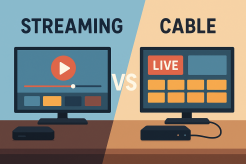How to Stop Paying Overage Fees | Family Phone Data Tips That Save Money

Nobody likes surprise charges on their phone bill — especially those annoying overage fees that seem to appear every month. If you’re tired of paying extra for data, switching to a family plan is a great first step toward saving money. But while shared plans are convenient and budget-friendly, they come with one big challenge: managing data usage.
In most households, the monthly data allocation doesn’t get split evenly. Maybe the kids are streaming YouTube all day, while someone else is working remotely or watching Netflix during their commute. Before you know it, you’ve hit your data limit — and your internet slows to a crawl or, worse, you get charged extra.
The good news? You can take control of your family’s data habits, lower your bill, and even cut back on screen time for your kids. Let’s look at how to make it happen.
1. Set Up Screen Time Limits on Your Child’s Smartphone
One of the easiest ways to manage your family’s data use is by setting up Screen Time on your child’s smartphone. This built-in feature (available on both iOS and Android) helps you monitor and limit how long your kids spend on certain apps — and when they can use them.
You can schedule downtime, set app time limits, and even block specific apps during certain hours, like homework or bedtime. It’s also an excellent tool to help your kids balance their screen habits and stay off their phones when they shouldn’t be online.
Here’s how to enable Screen Time and set downtime limits:
Go to your phone’s Settings.
Tap Screen Time (on iPhones) or Digital Wellbeing & Parental Controls (on Android).
Go to Downtime and toggle it on. Set specific times when your child won’t be able to use the phone or certain apps.
Return to the main Screen Time settings page.
Choose Always Allowed and select essential apps like Phone, Messages, or Google Maps that you still want your child to access.
This feature doesn’t just help you manage data — it can also reduce your child’s overall screen time and promote healthier digital habits.
2. Download GPS Maps for Offline Use
Navigation apps like Google Maps or Waze are notorious for eating up mobile data, especially when you’re on long trips. But here’s a little trick: you can use them offline without using any wireless data.
Before you head out, connect your phone to Wi-Fi and download maps for your route. Once downloaded, you can navigate seamlessly, even without an internet connection. This method is a lifesaver for frequent travelers or parents who often drive their kids to sports games or school events in low-signal areas.
3. Always Use Wi-Fi Whenever Possible
This one might sound obvious, but it’s one of the easiest ways to reduce mobile data usage: connect to Wi-Fi whenever it’s available. When you’re using Wi-Fi, your phone isn’t using your mobile data — so you’re essentially saving money without even trying.
Many public places offer free Wi-Fi, including:
Coffee shops
Restaurants
Libraries
Supermarkets
Airports
If you’re not sure where to find a reliable signal, your phone’s Wi-Fi settings usually display nearby networks automatically. Connecting to one of these free hotspots is like giving your data plan a break.
4. Save Downloads and Updates for When You’re on Wi-Fi
Another major data drain comes from downloads and automatic updates. Whether it’s your favorite app, a new OS update, or even a large photo backup, downloading on mobile data can quickly eat through your plan.
To save data:
Wait until you’re connected to Wi-Fi before updating apps or your operating system.
Turn off automatic app updates over mobile data in your settings.
Avoid downloading new podcasts, music, or shows while you’re away from Wi-Fi.
If you’re using streaming platforms for entertainment or online gaming, make sure you’re on a Wi-Fi network before hitting play or starting a download. Those high-definition videos and large game files can devour your data plan in minutes.
5. Turn Off Wi-Fi Assist or Smart Network Switch
Both iPhones and Android smartphones include features that automatically switch to mobile data when your Wi-Fi signal weakens. On iPhones, it’s called Wi-Fi Assist, and on Android, it’s often referred to as Smart Network Switch.
While these features sound helpful, they can quietly drain your data in the background. If your Wi-Fi drops for even a second, your phone instantly switches to your data plan — even if you don’t notice.
Here’s how to disable these settings:
iPhone: Go to Settings → Cellular → Scroll down and turn off Wi-Fi Assist.
Android: Go to Settings → Connections → Wi-Fi → Advanced Settings and disable Smart Network Switch (or similar options depending on the brand).
Turning these off ensures your phone sticks to Wi-Fi whenever possible, even if the connection is a bit slower.
6. Monitor Your Data Regularly
Most people don’t realize how quickly their data disappears until it’s too late. Keep an eye on your usage by checking your phone’s built-in data tracker or your provider’s mobile app.
You’ll be able to see which apps are using the most data — social media, video streaming, and online games are often the biggest culprits. Once you identify them, you can take steps to restrict their background activity or switch to lower-quality streaming settings.
7. Consider Upgrading to an Unlimited Data Plan
If your family consistently uses more data than your plan allows, it might be time to look into an unlimited data plan. While these plans can cost more upfront, they often save money in the long run by eliminating overage charges.
Before switching, compare different options from your cell phone provider. Some carriers even offer flexible unlimited plans where speeds slow down only after you hit a specific threshold — ideal for families who use moderate amounts of data but want peace of mind.
Still, make sure you’re not overpaying for features you don’t need. Review your family’s actual usage to find a plan that matches your lifestyle and habits.
8. Bonus Tip: Teach Smart Data Habits
Technology can be a great tool for education and entertainment, but setting boundaries helps everyone in your household use it more mindfully. Encourage your kids to:
Download videos and music while on Wi-Fi.
Limit social media and streaming time.
Use offline apps for games or learning.
Over time, these small changes can make a huge difference in both data usage and digital wellbeing.
Final Thoughts
Cutting down your phone bill doesn’t mean cutting back on convenience. With a few small adjustments — using Wi-Fi more often, setting app limits, and monitoring your data — you can easily avoid overage fees and keep your family connected without the stress.
If you’re still paying extra for data every month, consider checking your internet service provider’s latest offers or upgrading to a plan that better suits your household’s needs.
After all, saving money while staying connected is something everyone in the family can get behind.
0 of 0
Related Posts

Tue, Nov 25, 2025 10:49 AM
cheap internet offersBest Internet Providers Today: Finding the Right Speed, Value, and Reliability
Discover the best internet providers for speed, value, and reliability. Learn how to choose the right ISP based on usage, location, and connection type in this in-depth guide.

Mon, Nov 24, 2025 9:38 PM
cable dealStreaming vs. Cable: Which TV Service Truly Delivers the Better Experience?
Explore the complete comparison of streaming vs cable TV. Learn the pros, cons, costs, and performance differences to decide which service fits your lifestyle.

Mon, Nov 24, 2025 5:05 PM
cheap internet plansCost of Internet in a New Home: What Every Mover Should Know
Discover the real cost of internet in a new home, including hidden fees, rural options, and budget-friendly plans for families.

Fri, Nov 21, 2025 7:39 AM
Internet BundlesTop Internet Providers for Small Businesses Today
Discover the top internet providers for small businesses, including Verizon, AT&T, Spectrum, Comcast, and Viasat. Compare speeds, features, pricing, and reliability to find the best connection for your business.

Fri, Nov 21, 2025 4:00 AM
Internet BundlesBest Rural Internet Providers in the US: What to Know Before You Choose
We have schedules, rates, and pricing for the top three big internet providers in rural America. Since few internet providers create networks in small towns, your internet choices in rural areas are minimal. In rural America, however, Xfinity, CenturyLink, and Viasat all provide internet access.